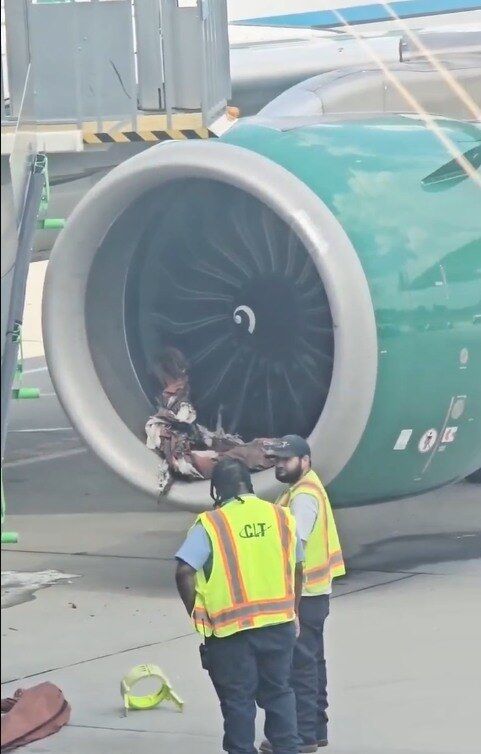On August 16, 2025, Charlotte Douglas International Airport experienced a rare and dramatic aviation mishap that left hundreds of passengers stranded for nearly half a day. A Frontier Airlines Airbus A320, tail number N365FR, scheduled to operate Flight F93134 from Charlotte to New York’s LaGuardia Airport, became inoperable when a ground air-conditioning hose was sucked into one of its engines during pre-departure preparations.
The incident, witnessed by both ground crew and waiting passengers, highlighted how quickly routine operations can spiral into chaos. The aircraft had arrived earlier that morning from Philadelphia as Flight F92387, landing at 10:25 a.m. By early afternoon, boarding for the next flight was underway when the accident occurred.
Standard procedure involved connecting a ground air-conditioning unit to the jet to cool the cabin while the engines remained off, reducing fuel consumption and noise during turnaround. However, as preparations began for engine start, the left engine—a CFMI LEAP-1A26 turbofan—generated enough suction to pull the unsecured hose into its intake. Within seconds, the hose was shredded, prompting an immediate shutdown and emergency response from ramp personnel.
Fortunately, no injuries were reported among passengers, crew, or ground staff. But the aircraft was damaged and could not continue its journey without thorough inspection and repair. Frontier Airlines quickly sought a replacement, but with summer travel at its peak, passengers were delayed for nearly nine hours before departing for New York.
The disruption caused a social media stir. Travelers shared photos of the stranded aircraft and speculated on the cause before official statements were released. Some initially misidentified the plane as an A321, though records confirmed it was an Airbus A320-251N, a 5.7-year-old aircraft with manufacturer serial number 9340, delivered in June 2019, and a reliable workhorse in Frontier’s fleet.
Aviation experts note that while rare, ground-equipment ingestion is not unprecedented. Engines on modern narrow-body aircraft like the A320 generate significant suction even at low power, capable of pulling unsecured objects from several feet away. Hoses, cones, and even loose baggage carts can become hazards if not properly positioned during engine start. Such incidents underscore the importance of strict ground safety protocols.
Frontier Airlines has not disclosed the full extent of the damage or whether the engine will require replacement. Jet engines like the LEAP-1A26 cost millions of dollars, and even repairable damage can cause major operational disruptions. Downtime for a single aircraft in an ultra-low-cost carrier’s fleet can ripple across schedules, affecting crews, subsequent flights, and customer service.
Passengers expressed mixed reactions. Some appreciated Frontier’s eventual replacement aircraft and continuation of service, while others voiced frustration over the lengthy delay, minimal updates, and lack of clear communication while stranded. In the age of instant social media coverage, such incidents highlight the critical role of passenger relations during mechanical disruptions.
The Federal Aviation Administration (FAA) is expected to review the event, focusing on whether the hose was correctly positioned, if engine-start procedures were properly followed, and whether additional safeguards or training are needed to prevent recurrence. Charlotte Douglas International, one of the busiest U.S. airports, handles hundreds of daily aircraft movements, making seamless coordination between airlines, contractors, and ground staff essential.
Though no one was harmed, the incident serves as a reminder that aviation safety relies not only on pilots and aircraft design but also on the meticulous execution of ground operations. A single unsecured air-conditioning hose was enough to render a $100 million aircraft inoperable in seconds.
Currently, N365FR remains grounded pending inspection, while Frontier has rotated other aircraft to cover schedules. Flight F93134 passengers eventually arrived in New York nearly nine hours late, frustrated but relieved. For the airline and regulators, the episode is a case study in how minor lapses on the ramp can escalate into major operational disruptions.
In commercial aviation, every piece of equipment and procedure serves a purpose. The Charlotte Douglas incident underscores the reality that even the smallest oversight can have far-reaching consequences—not just for waiting passengers, but for airlines managing aircraft availability, crews, and safety on tight margins.
